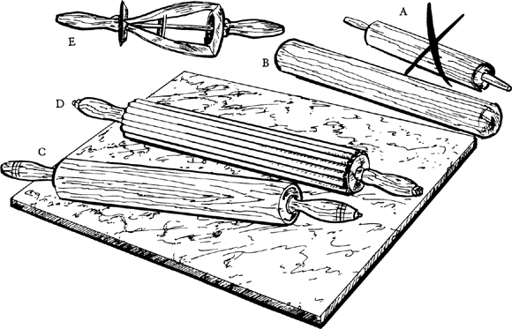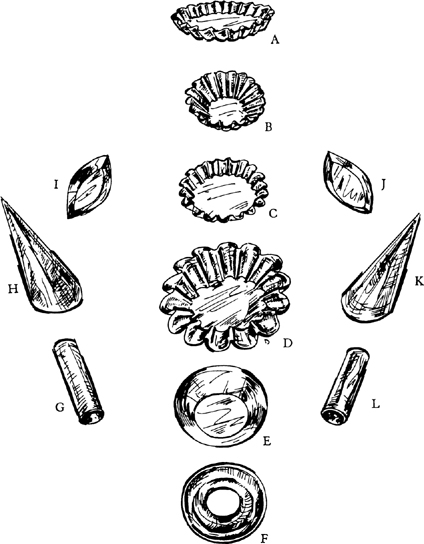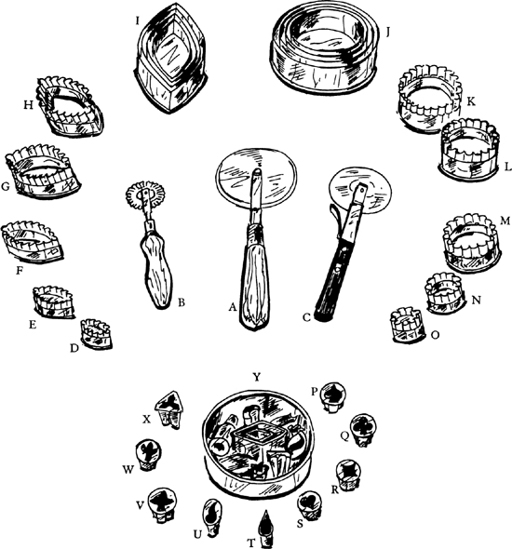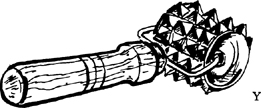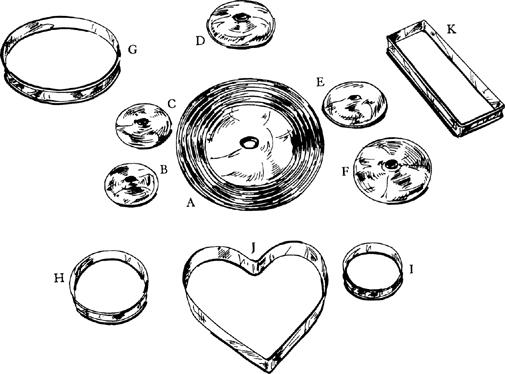Mastering the Art of French Cooking, Volume 2 (225 page)
Read Mastering the Art of French Cooking, Volume 2 Online
Authors: Julia Child

PASTRY—ROLLING, SCRAPING, AND GLAZING
If you are going into
quiches, pâtés en croûte
, and especially into the fascinating realm of
French puff pastry
, get yourself a slab of marble 2 feet square and ¾ to 1 inch thick; its coolness helps prevent the dough from softening, and its smooth surface is easy to scrape clean.
One or two professionally designed rolling pins with rolling surfaces 16 to 18 inches long are essential for any pastry work—the silly toy pin (A), still sold to debutante cooks, makes hard work of any rolling operation. The French boxwood pin,
rouleau à pâtisserie en buis
(B) or its Italian equivalent, both without handles, are as useful for rolling as they are for beating chilled pastry into rolling shape. The fine professional American ball-bearing pin (C)
is heavy enough to do half the work for you, and the cannelated pin (D),
le Tutove
, is especially designed to spread out the layers of butter inside the croissant dough as you roll. The rotary
croissant cutter (E) then finishes the operation.
For scraping pastry off the work surface, and also for cutting and chopping dough, the hardware-store paint scraper (F) does almost as good a job as the French pastry scraper,
coupe-pâte
(G). The pastry blender (H), with its multiple chopping blades, cuts the butter into the flour when you are making pie dough by hand—it prevents the hot-finger syndrome that causes cardboard pastry.
Several pastry brushes (I) are needed, for glazing the tart with beaten egg as well as for general basting; be sure to buy ones designed for pastry or for basting, since cheap brushes leave bad tastes and drop hairs.
SMALL MOLDS—PETITS MOULES—FOR TARTLETS, BRIOCHES, PETITS FOURS
These should be in tinned metal,
fer-blanc
which is less likely to cause sticking problems than aluminum; if you have to scrub them after baking, warm them briefly and rub lightly with oiled paper toweling to keep the molds from rusting or sticking. Buy at least a dozen of whatever models you chose, so that you can form and bake as many at once as possible. Tartlet molds (A,C,I,J,E) are usually ½ inch deep and from 1½ to 3 inches in diameter or length. Individual
brioches
are usually baked in the round fluted molds (B and D), although these molds can serve for tartlets and entrée pastries too. Baby savarins are formed and baked in the ring mold, F, while
cornets
and
rouleaux
are formed around the metal cream
horns (H and K) and tubes (G and L).
CUTTERS—DÉCOUPOIRS; EMPORTE-PIÈCES
If you are going into serious pastry work, sets of round and oval cutters neatly packed in tin boxes make storage and retrieval no problem at all. Oval cutters come plain (
unis
), I, or fluted (
cannelés
), D–H, with the smallest in the set being 1⅝ inches long and the largest 4¾ inches. Sets of plain (J) and fluted round cutters (K–O) go from ⅝ inch to 4 inches in diameter. The tiny cutters in the foreground,
découpoirs à truffes
(P–X), make designs in truffle slices, egg whites, and other small decorative elements for aspics and pastries. Something like the ravioli wheel (B), the large Italian wheel (A), or the pastry wheel (C) is always useful for pie doughs, puff pastries, and general dough cutting.
When you must prick the sheet of dough for
Napoleons
, all over at ¼-inch intervals, a fork takes quite a number of minutes while the
roller pricker (Y), which doubles as a meat-tenderizer, covers the area in a few passes; its cast-aluminum head is 2 inches in diameter and its sturdy wooden handle is 4 inches long.
FLAN RINGS AND VOL-AU-VENT CUTTERS
Flan rings,
formes sans fond
(G,H,J,K, and I), come in all sizes and many shapes; they are designed especially for making the free-standing tart shells, pie shells, and
quiches
illustrated in Volume I, pages 143–5. A set of graduated
vol-au-vent
cutters (A–F) comprises 12 disks slightly raised to provide a finger hold in the center; disks range in size from 4 to 10½ inches in diameter. They are invaluable not only for cutting the
vol-au-vent
, but also for making circles in floured pastry sheets, like the
cookie cups
, or for any other circular cutting or marking operations, like the
free-standing tart shells
.

